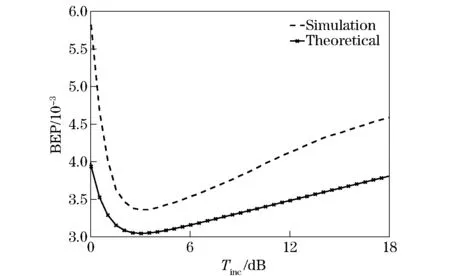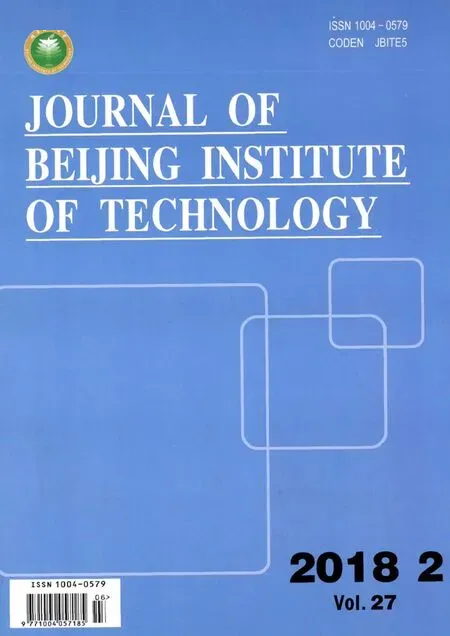Log Likelihood Ratio-Based Relaying for Distributed Turbo Codes
2018-06-15PeiyaoYangHaiLiandShujuanHouSchoolofInformationandElectronicsBeijingInstituteofTechnologyBeijing100081China
Peiyao Yang, Hai Li and Shujuan Hou(School of Information and Electronics, Beijing Institute of Technology, Beijing 100081, China)
To improve the performance of cooperative communication, B.Zhao et al.proposed distributed turbo coding (DTC)[1]based on the principle of turbo codes.In DTC scheme, the source broadcasts the recursive convolutional codes (RSC) to both the relay and the destination. The relay decodes the received signals, then interleaves, re-encodes and forwards the encoded symbols to the destination. The signals received at the destination from both the source and the relay consists of encoded symbols and forms a DTC for the decoder.Researchers have demonstrated that the DTC scheme can perform close to the theoretic outage probability bound of decode-and-forward relaying[2].
Since the performance of the DTC scheme largely depends on the decoding performance at the relay, most of the existing studies focused on encoding structures designed for improving the decoding success rate at the relay[3-5]. Moreover, L.Maret et al.[6]combined the DTC scheme with hybrid automatic repeat request (HARQ) to enhance the transmission robustness with limited spectral efficiency degradation.
The assumption made by the above studies is that the relay can decode received signals correctly. To further improve the performance of cooperative networks, Y.Li et al.[7]proposed a distributed turbo code scheme with soft information relaying (DTC-SIR) while imperfect decoding occurs at the relay.The DTC-SIR scheme can effectively mitigate error propagation for imperfect decoding and improve the performance.X.Bao et al.[8]applied Gaussian approximation to the decoder-LLRs at the relay and then forwarded soft information to the destination(SIR-LLR).Y.Hairej et al.[9]also proposed a SIR-based relaying scheme with the forwarded soft symbols serving as a priori information to assist the iterative turbo decoding at the destination. However, these SIR-based relaying schemes assumed that the relay can forward this soft information as unconstrained analog values to the destination. Also the destination requires the mean value of soft information to obtain the soft information model[10].
Furthermore, F.Onat et al.[11]proposed a SNR-based threshold relaying scheme that the relay only forwards symbols when its signal-to-noise ratio (SNR) is above a pre-defined threshold.Al-Habian et al.[12]proposed a LLR-based threshold relaying scheme that forwards only reliable hard-decision symbols to the destination. However, the threshold in the scheme needs to be updated every time when new signals are received for DTC scheme and when the value of the threshold is too complex to calculate.
Motivated by the previous research, we proposed a DTC with LLR-based threshold relaying scheme.In the proposed scheme, a threshold is used at the relay to measure the reliability of decoder-LLRs while imperfect decoding occurs at the relay. To mitigate error propagation, only reliable symbols will be forwarded to the destination. Signals received from both the source and the relay are combined together using MRC before decoding. In order to calculated the optimal threshold of decoder-LLRs,an equivalent model of decoder-LLRs is investigated, and the BEP expression of the proposed scheme is derived in this paper.
1 System Model
In this paper, we consider the scenario of a traditional two-hop relay network. The system model of the networkis shown in Fig.1.We assume that the source and the relay transmit signals over orthogonal channels, for which the data transmission is divided into two time slots.In the first time slot, the RSC encoded signals are broadcasted from the source to both the relay and the destination. The signals of the S-R link and the S-D link can be expressed as
ysr=hsrxs+nsr
(1)
ysd=hsdxs+nsd
(2)

In the second time slot, the relay interleaves the decoded information symbols, re-encodes the symbols and then forwards signals to the destination when decoding is successful at the relay. A distributed turbo decoding is applied at the destination. Otherwise, only decoded symbols with its LLR greater than a pre-defined thresholdTincare forwarded to the destination.In this case, the destination combines signals received from both the source and the relay using MRC before decoding.

Fig.1 System model of the proposed DTC scheme
2 Performance Analysis
2.1 Gaussian approximation model of decoder-LLRs
Since the LLRs of received signals are independent and have identically Gaussian distribution, the decoder-LLRsLufrom the output of the log-MAP decoder for convolutional codes follows an approximated Gaussian distribution[13]. Therefore,Lucan be written as
Lu=μLux+nLu
(3)

For a given channel code, the distribution ofμLuis obtained by simulations from a Log-MAP decoder with fixed average SNR under Rayleigh fading channel.In this paper, a (1,5/7)8RSC code of length 1 002 and rater=1/2 is employed.According to the simulation results, the distribution ofμLuunder fixed Rayleigh fading channel follows an approximated exponential distribution, which has a mean E{μLu}=1/λμ. Accordingly, the PDF ofμLucan be expressed as
fμ(μ)=λμe-λLuμ,μ≥0
(4)
Then, the PDF ofLucan be derived as

(5)
2.2 BEP analysis
According to the characteristics of log-MAP decoder, we assume that if the decoder can decode correctly, the decoder-LLRs would be above a fixed valueTp. The BEP of the proposed scheme before destination decoding can be expressed as
Pe(εd)=Pe(εd,|Lu|≤Tinc)+
Pe(εd,Tinc<|Lu|≤Tp)+Pe(εd,|Lu|>Tp)
(6)
where the first term in Eq.(6) is the BEP at the destination when the decoded symbol is not selected for retransmission, while imperfect decoding occurs at the relay.The second term in Eq.(6) represents the BEP at the destination when the decoded symbol is selected for retransmission when imperfect decoding occurs at the relay. The third term of Eq.(6) is the BEP at the destination when correct decoding occurs at the relay. To simplify the analysis of the proposed scheme without losing generality, we assume that all symbols transmitted from the source is +1.
If the decoder-LLR at the relay is less than the pre-defined thresholdTinc, the relay will keep silent and only S-D link signalsysdwill be received at the destination. The BEP can be derived as

(7)
如今,普法工作的专门法仍是立法领域的薄弱环节,基层国家机关在法律允许的范围内可以尝试通过制定普法规范性文件来规范普法工作,但是无论做任何尝试,都必须坚持落实公开公示制度。在法律普及过程中,各部门和单位必须事先制定法治宣传教育工作规划,及时在门户网站上公告,接受社会监督。同时建立了报告和调度系统。建立检验监督制度,实行集中检查,组织互查,随机抽样检查等,每半年对各部门,单位的工作和发展情况进行检查和评审。此外,还需要建立评估系统,对各地区(功能区)和各市实施“谁执法谁普法”普法责任制的情况进行综合评估。
When imperfect decoding occurs at the relay and the decoder-LLR is greater than the thresholdTinc, the relay will forward hard-decision of decoder-LLR to the destination. The BEP can be derived as

(8)
The first term and second term in Eq.(8) are the BEP when both the incorrectly decoded symbols and correctly decoded symbols are selected for retransmission. The BEP at the relay when decoded symbols are selected for retransmission can be expressed as

(9)

(10)
Pe(εprop|εr,Tinc<|Lu|≤Tp) is the BEP at the destination when error is propagated to the destination. It can be expressed as[14]
(11)

(12)
If the relay can decode the received signals correctly, then the interleaved re-encoded symbols will be forwarded to the destination. The BEP at the destination can be expressed as
(13)
2.3 Optimal threshold
To obtain the optimal threshold, we can minimize Eq.(6) by solving the equation ∂Pe(εd)/∂Tinc=0. After some manipulations, we have

(14)

(15)


3 Simulation Results
We consider a rate 1/2, 4-state RSC encoder with generator polynomial (1, 5/7)8.The frame length is 1 002 symbols and BPSK modulation is employed.



Fig.2 PDF of μLu and exponential distribution

Fig.3 Comparison of the BEP before decoding at the destination with respect to Tinc
In Fig.4, we compared the proposed DTC scheme with other DTC schemes, including: ① traditional DTC; ② SNR-based threshold DTC; ③ SIR-LLR DTC.Here, the “SNR-based threshold DTC” implies that the SNR of LLR approximation model determines the SNR threshold of decoder-LLRs at the relay[14].We observe that the proposed DTC scheme outperforms the SNR-based threshold DTC because the measure of decoder-LLRs is more efficient than the measure of received SNR of S-R link. Although the SIR-LLR DTC scheme outperforms the proposed DTC scheme, the SIR-LLR DTC scheme assumed that the relay forwards soft information as unconstrained analog values to the destination. Moreover, the parameter of soft information needs to be updated every time when new decoder-LLRs are obtained, and it is rather time consuming to obtain theμLuof soft information.

Fig.4 End-to-end BEP performance when dsd=1, dsr=drd=1/2
4 Conclusion
In this paper, we proposed a LLR-based relaying scheme for distributed turbo codes. To distinguish reliable symbols from decoder-LLRs when imperfect decoding occurs, a LLR-based threshold of decoder-LLRs is calculated. To obtain the optimal threshold, we investigate the approximated model of the decoder-LLRs, and then derive the BEP expression of the proposed scheme.Simulation results demonstrate that the proposed model of decoder-LLRs coincides with the simulated ones. Moreover, the proposed DTC scheme outperforms the SNR-based threshold DTC scheme since the LLR-based threshold is more efficient than the SNR-based threshold.
[1] Zhao B, Valenti M C. Distributed turbo coded diversity for relay channel[J]. Electronics Letters, 2003, 39(10):786-787.
[2] Valenti M C, Zhao B. Distributed turbo codes: towards the capacity of the relay channel[C]∥Vehicular Technology Conference (VTC Fall), 2003 IEEE 58th IEEE, Orlando, Florida, USA, 2003:322-326 Vol.1.
[3] Karim M A, Yuan J, Chen Z. Improved distributed turbo code for relay channels[C]∥2009 IEEE 70th Vehicular Technology Conference (VTC Fall), Anchorage, Alaska, USA,2009:1-5.
[4] Karim M A, Yuan J, Chen Z. Nested distributed turbo code for relay channels[C]∥2010 IEEE 71th Vehicular Technology Conference (VTC Spring), Taipei, Taiwan, China,2010.
[5] Hou Shujuan, Li Lingyun, Qin Xuefang. Systematic-bit-selection distributed turbo code with selective-relaying[J]. Journal of Beijing Institute of Technology, 2014, 23(1):73-77.
[6] Maret L, Ktenas D. Distributed turbo coding techniques with HARQ at relays for LTE-A[C]∥2013 IEEE 77th Vehicular Technology Conference (VTC Spring), IEEE, Dresden, Germany, 2013.
[7] Li Y, Vucetic B, Wong T F, et al. Distributed turbo coding with soft information relaying in multihoprelay networks[J]. IEEE Journal on Selected Areas in Communications, 2006, 24(11):2040-2050.
[8] Bao X, Li J. Efficient message relaying for wireless user cooperation: decode-amplify-forward (DAF) and hybrid DAF and coded-cooperation[J]. Wireless Communications IEEE Transactions on, 2007, 6(11):3975-3984.
[9] Hairej Y, Darmawan A, Morikawa H. Cooperative diversity using soft decision and distributed decoding[C]∥Mobile and Wireless Communications Summit, 16th IST IEEE, New York,USA,2007:1-5.
[10] Jayakody D N K, Flanagan M F. A soft decode-compress-forward relaying scheme for cooperative wireless networks[J]. IEEE Transactions on Vehicular Technology, 2016, 65(5): 3033-3041.
[11] Onat F, Fan Y, Yanikomeroglu H, et al. Asymptotic BER analysis of threshold digital relaying schemes in cooperative wireless systems[J]. IEEE Transactions on Wireless Communications, 2008, 7(12):4938-4947.
[12] Al-Habian G, Ghrayeb A, Hasna M, et al. Threshold-based relaying in coded cooperative networks[J]. IEEE Transactions on Vehicular Technology, 2011, 60(1):123-135.
[13] Brink S T. Convergence behavior of iteratively decoded parallel concatenated codes[J]. IEEE Transactions on Communications, 2001, 49(10):1727-1737.
[14] Onat F A, Adinoyi A, Fan Y, et al. Threshold selection for SNR-based selective digital relaying in cooperative wireless networks[J]. IEEE Transactions on Wireless Communications, 2008, 7(11):4226-4237.
[15] Kwon T, Lim S, Seo W, et al. LLR-based symbol selective transmission with a near-optimal threshold to minimize BEP for demodulation-forward relay systems.[J]. IEEE Transactions on Wireless Communications, 2010, 9(2):540-545.
猜你喜欢
杂志排行
Journal of Beijing Institute of Technology的其它文章
- Dynamic Mechanical Characteristics and Damage Evolution Model of Granite
- Combustion Properties of Metal Particles as Components of Modified Double-Base Propellants
- Optimization of Crosswalk Width Based on Bi-Directional Pedestrian Crossing Time at Signalized Intersections
- Efficient Activation Method of Hardware Trojan Based on Greedy Algorithm
- Estimation of Thermal Imaging System Operating Range Based on Background Radiation
- Network Sorting Algorithm of Multi-Frequency Signal with Adaptive SNR
